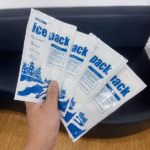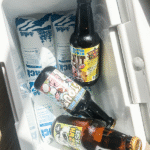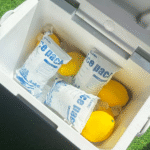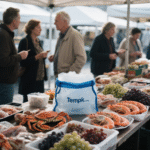How can a cold supply chain keep food and medicines safe in 2025?
Einführung:
Maintaining the integrity of temperature sensitive goods has never been more critical. A Kühllieferkette—a network of refrigerated storage, transportation and monitoring systems—ensures products like vaccines, seafood and plant based foods remain within safe temperature ranges from farm to fork. Global research shows that the cold chain logistics market is valued at about US$436 billion in 2025 und wird voraussichtlich übertroffen werden US$1.3 trillion by 2034. This explosive growth is driven by booming e commerce, rising demand for biologics and fresh produce, and stricter safety regulations. In diesem Leitfaden, you’ll learn how the cold supply chain works, why it’s vital, and what innovations are reshaping it.
What is a cold supply chain and why does it matter in 2025? Understand the components and processes that keep products safe, including warehouses, insulated vehicles and monitoring systems.
How do AI, IoT and blockchain transform cold supply chains? Learn about predictive analytics, real time monitoring and traceability tools that reduce spoilage and costs.
Which market trends and regional insights shape the cold chain’s future? Discover growth drivers like e commerce, plant based foods and regional investments.
How can businesses build resilience and sustainability? Gain practical tips on energy efficiency, renewable power and compliance with new regulations.
What are common questions about the cold supply chain? Explore concise answers to high search queries to deepen your understanding.
What is a cold supply chain and why is it vital in 2025?
Antwort:
A cold supply chain is a temperature controlled network that ensures perishable goods stay within specific temperature ranges from production to consumption. It combines refrigerated warehouses, insulated transport vehicles, specialized packaging and real time monitoring to maintain product quality. In 2025, demand is surging because consumers expect fresh, safe products and regulators are enforcing stricter food and drug safety standards. The cold supply chain supports industries ranging from pharmaceuticals and biologics to seafood, Fleisch, plant based proteins and meal kits. Ohne es, products can spoil or become unsafe, leading to financial losses and health risks.
Erweiterte Erklärung:
Imagine ordering a meal kit on a warm summer day. The ingredients travel through a carefully orchestrated chain of refrigerated warehouses and insulated trucks to arrive at your doorstep fresh and safe. This network is the cold supply chain. In 2025, the industry is booming: analysts estimate the market will top US$436 billion and could reach over US$1.3 trillion by 2034. Drivers include expanding global food trade, rapid growth in online grocery orders and technological innovations that make monitoring easier. Regulatory pressure has also intensified. Die USA. Gesetz zur Modernisierung der Lebensmittelsicherheit (FSMA) Regel 204, effective January 2025, requires high risk foods to be traceable within 24 hours, while the EU’s Good Distribution Practices mandate continuous electronic record keeping. Für Unternehmen, adopting cold chain best practices isn’t optional; it’s essential for compliance, product quality and customer trust.
What are the key components of a modern cold supply chain?
Detaillierte Informationen:
Modern cold supply chains rely on multiple components working together:
Refrigerated storage and pre cooling: Facilities cool products to the appropriate temperature quickly after harvest or manufacturing. Zum Beispiel, tragbare kryogene Gefriergeräte can maintain ultra low temperatures between –80 °C and –150 °C for biologics and cell therapies.
Insulated transportation: Vehicles such as refrigerated trucks, reefer containers and temperature controlled railcars maintain cold conditions during transit. Some fleets use electric or hybrid refrigeration units, reducing emissions and operating costs.
Intelligente Überwachungsgeräte: IoT -Sensoren, GPS trackers and data loggers report temperature, Luftfeuchtigkeit und Standort in Echtzeit. These devices enable immediate action if conditions drift outside the safe range and provide verifiable records for regulators.
Data analytics and AI: Artificial intelligence analyses real time and historical data to forecast demand, predict equipment failures and optimize delivery routes.
Traceability systems: Blockchain and digital records create tamper proof logs of product journeys, enhancing transparency and simplifying audits.
Sustainable technologies: Solarbetriebene Kühlung, natural refrigerants and recyclable insulated packaging reduce energy consumption and environmental impact.
| Komponente | Beschreibung | Praktische Bedeutung |
| KI-gestützte Routenoptimierung | Algorithmen analysieren den Verkehr, weather and delivery schedules to choose the most efficient paths | Schnellere Lieferungen, lower fuel use and reduced spoilage |
| Vorausschauende Wartung & Analytik | AI predicts equipment failures and demand surges, Dies ermöglicht proaktive Reparaturen und eine bessere Kapazitätsplanung | Less downtime and improved customer satisfaction |
| IoT-Sensoren und Echtzeit-Tracking | Geräte überwachen die Temperatur, Luftfeuchtigkeit und Standort, providing continuous visibility | Sofortige Benachrichtigungen, weniger Produktverluste und eine bessere Einhaltung gesetzlicher Vorschriften |
| Rückverfolgbarkeit der Blockchain | Distributed ledgers ensure tamper proof data on product movement and temperature | Transparenz, weniger Betrug und vereinfachte Prüfungen |
| Solarbetriebene Kühlung | Solar panels power cold storage in energy scarce areas | Niedrigere Energiekosten und geringerer CO2-Fußabdruck |
| Tragbare kryogene Gefriergeräte | Mobile units maintain ultra low temperatures for biologics | Enables flexible distribution of high value pharmaceuticals |
| Nachhaltige Verpackung | Biodegradable wraps and reusable cold packs decrease environmental impact | Supports corporate sustainability goals and compliance |
Praktische Tipps und Empfehlungen
Integrieren Sie KI mit menschlichem Fachwissen: Treat AI as a decision support tool. Combine algorithmic recommendations with your team’s experience to adapt to unforeseen conditions and maintain product quality.
Investieren Sie in die IoT-Infrastruktur: Stellen Sie Sensoren im gesamten Speicher bereit, transportation and last mile delivery. Ensure the data flows into a central platform for analysis and alert generation.
Entdecken Sie erneuerbare Energien: Evaluate solar panels for warehouses and refrigerated trucks. Solar rates can range from 3.2 to 15.5 cents per kWh, offering potential savings compared to average commercial utility rates.
Pilot-Blockchain-Projekte: Beginnen Sie mit einer begrenzten Produktlinie, um die Vorteile der Blockchain für Transparenz und Compliance zu bewerten. Scale up after demonstrating return on investment.
Trainiere dein Team: Informieren Sie das Personal regelmäßig über die Handhabungsverfahren, data logging and emergency responses. A well trained workforce reduces the risk of temperature excursions.
Fallstudie: In Südostasien, a pharmaceutical distributor implemented blockchain based tracking for vaccine shipments. Temperatures, humidity and travel times were logged on a distributed ledger accessible to manufacturers, transporters and clinics. Combining blockchain with solar powered storage and IoT sensors ensured safe delivery of vaccines to remote areas and reduced losses.
How can you build resilience and sustainability into your cold supply chain?
Antwort:
Resilience and sustainability require a combination of technology, process improvements and strategic planning. The cold supply chain is no longer just about keeping items cold; it’s about being prepared for disruptions, reducing environmental impact and maintaining regulatory compliance. Here are key strategies:
Adopt predictive and preventative maintenance: Use AI and sensor data to predict equipment failures and schedule maintenance before breakdowns occur. This prevents costly product losses and unplanned downtime.
Enhance data visibility: Consolidate data from multiple sources—warehouses, vehicles and suppliers—into a single platform. Predictive analytics helps you allocate resources, forecast demand and monitor compliance with temperature ranges.
Upgrade aging infrastructure: Many cold storage facilities worldwide are decades old and energy intensive; Zum Beispiel, in Japan, one third of cold storage facilities are over 40 years old. Investing in modern, energy efficient buildings with proper insulation and natural refrigerants can cut energy costs and emissions.
Plan for regulatory changes: Stay ahead of new rules such as FSMA Rule 204, which requires traceability of high risk foods within 24 Std., and the EU’s Good Distribution Practices for pharmaceutical products. Ensure your systems record and report data accordingly.
Use energy efficient equipment and renewable power: Transition to electric or hybrid refrigeration units, natural refrigerants and solar powered warehouses. These investments reduce both operating costs and carbon footprints.
Diversify suppliers and transportation options: Develop contingency plans for geopolitical disruptions or extreme weather. Having multiple supply routes and modes reduces the risk of complete shutdowns.
Leverage reusable and recyclable packaging: Reusable insulated boxes and biodegradable thermal wraps reduce waste and align with circular economy goals.
Erweiterte Erklärung:
Marktdynamik in 2025 underscore why resilience and sustainability are essential. The global cold chain market is projected to reach US$393–453 billion in 2025 and accelerate to US$1.63 trillion by 2035. Asia Pacific is expected to become the largest regional market due to government subsidies, urbanisation and booming e commerce, while North America and Europe invest heavily in compliance and sustainability initiatives. Demand is surging for biologics, advanced therapies and fresh foods, yet infrastructure gaps in regions like Latin America and Africa hinder growth. Technology adoption is the clear solution: IoT devices provide real time monitoring down to 1–5 minute intervals, and AI optimises routes, predicts demand and schedules maintenance. In der Zwischenzeit, sustainable innovations like natural refrigerants, solar power and electric reefer trucks reduce emissions and operating costs. Investing in resilience now allows companies to handle disruptions and meet growing consumer expectations for transparency, freshness and sustainability.
2025 latest cold supply chain development and trends
Trendübersicht:
In 2025, the cold supply chain is undergoing rapid evolution. The global market, valued at around US$405 billion in 2024, is expected to expand between US$393 billion and US$453 billion in 2025 before accelerating to US$1.63 trillion by 2035. Analystenprojekt a CAGR of 11–15 %, wobei der asiatisch-pazifische Raum das Wachstum anführt. Key drivers include the explosion of e commerce grocery delivery, the rise of biologics and advanced therapies, and growing consumer demands for visibility and traceability. Regulatory mandates such as the FSMA Rule 204 and the EU’s refrigerant phase out accelerate technology adoption. Sustainability is another force: companies adopt natural refrigerants, solar powered warehouses and electric vehicles to lower emissions and energy costs.
Neueste Fortschritte auf einen Blick
Markterweiterung: The cold supply chain market is projected to reach US$1.6 trillion by 2035, with Asia Pacific set to dominate due to rapid infrastructure build out and supportive government policies.
Pharma sector growth: The pharmaceutical cold chain logistics segment is valued at US$6.7 billion in 2025, steigt zu US$9.3 billion by 2034, driven by biologics and vaccines.
Consumer transparency: Surveys reveal that 99 % of consumers demand supply chain transparency, Und 75 % are willing to switch brands if they don’t get it. Traceability and real time data are now competitive differentiators.
Technology adoption: IoT, Ai, blockchain and automation are considered essential, nicht optional, for competitive cold supply chains. Sensors provide real time monitoring with 1–5 minute intervals, enabling rapid response to issues.
Sustainability actions: Companies adopt natural refrigerants, solar powered warehouses and electric or hybrid reefer fleets. Circular packaging—reusable containers and biodegradable wraps—helps meet eco friendly goals.
Regulatorischer Druck: The FSMA Rule 204 in the U.S. demands traceability within 24 hours for high risk foods; the EU and WHO enforce continuous monitoring and phase out harmful refrigerants.
Regional investment: Nations invest heavily in cold chain infrastructure, such as India partnering with the UN on cold chain programs and the Philippines investing US$53 million in new cold stores.
Markteinsichten:
The cold supply chain’s momentum reflects broader consumer and industry shifts. Asia Pacific’s rapid urbanisation and e commerce growth spur new warehouse construction, while North America focuses on compliance, sustainability and expansions in pharmaceutical logistics. Europe’s strict food and pharma regulations drive adoption of advanced monitoring and natural refrigerants. Latin America and Africa face infrastructure gaps but present significant growth potential once investment flows in. The pharmaceutical cold chain alone sees robust growth due to biologics and gene therapies, yet losses remain high: globally, mehr als US$35 billion is lost each year from temperature excursions, und bis zu 25 % of vaccines are wasted in some regions. These statistics highlight the urgency of adopting resilient and transparent cold supply chains.
FAQ
Frage 1: What’s the difference between a cold supply chain and cold chain logistics?
The terms are often used interchangeably. Kalte Lieferkette refers to the entire end to end network—from production to consumption—of temperature controlled storage and transportation. Kaltkettenlogistik focuses more on the transportation and operational processes within that network. Both are critical for preserving product integrity and ensuring safety.
Frage 2: How does IoT improve cold supply chains?
IoT devices such as smart sensors and GPS trackers provide real time temperature, Luftfeuchtigkeit und Standortdaten. When conditions drift outside safe ranges, the system sends alerts so teams can act immediately. IoT also generates detailed records to comply with food and pharmaceutical safety regulations.
Frage 3: Why is sustainability important in cold supply chains?
Cold supply chains consume significant energy and often rely on refrigerants with high global warming potential. Sustainable practices—like using solar powered refrigeration, natural refrigerants and recyclable packaging—reduce environmental impact while lowering energy costs. Customers and regulators increasingly demand eco friendly operations, making sustainability a competitive advantage.
Frage 4: How can small businesses adopt cold supply chain technologies?
Start with incremental steps: invest in portable refrigeration units or insulated containers appropriate for your products, and use affordable Bluetooth or Wi Fi sensors to monitor temperature. Cloud based platforms provide scalable data analytics and traceability without huge upfront costs. Seek industry alliances, grants or subsidies to offset the investment.
Frage 5: What are common challenges in cold supply chains?
Challenges include aging infrastructure, high energy costs, manual processes and data silos. Geopolitical disruptions and climate related events can also interrupt supply routes. Addressing these issues requires modern facilities, diversified logistics networks and predictive analytics to anticipate disruptions.
Anregung
Key Takeaways: The cold supply chain is a pivotal component of global commerce, valued at about US$436 billion in 2025 and projected to grow beyond US$1.3 trillion by 2034. It ensures that temperature sensitive foods and medicines remain safe from source to consumer. Critical components include refrigerated storage, insulated transportation, IoT-Überwachung, AI analytics, blockchain for traceability and sustainable technologies. The industry is rapidly evolving due to e commerce expansion, biologics growth, stricter regulations and consumer demand for transparency. Resilience and sustainability are essential: investing in modern infrastructure, renewable energy and predictive technologies mitigates risks and reduces environmental impact.
Umsetzbarer Rat: Begin by assessing your current cold supply chain: identify temperature critical stages, energy consumption and data gaps. Implement IoT sensors for real time monitoring and integrate them into a single data platform. Use predictive analytics to optimise routes, forecast demand and schedule maintenance. Upgrade facilities with energy efficient insulation and natural refrigerants, and explore solar power or hybrid refrigeration units. Train your staff regularly and engage with industry alliances such as the Global Cold Chain Alliance to access resources and best practices. Endlich, commit to transparency: share temperature data with customers, document compliance and adopt blockchain to build trust. By taking these steps, you’ll enhance product quality, reduce waste and position your business for long term success.
Um Tempk
Unternehmenshintergrund: Tempk is a leading provider of cold chain packaging, refrigeration and monitoring solutions. We specialise in designing insulated boxes, gel packs and portable freezers that keep products safe throughout the cold supply chain. Unser r&D team continually develops eco friendly options—including reusable packaging and solar powered storage—to reduce environmental impact. We also offer IoT enabled monitoring devices and data platforms to ensure you have real time visibility and compliance documentation.
Aufruf zum Handeln: To protect your temperature sensitive goods and stay ahead of regulatory and consumer expectations, consult with our cold chain experts. We can tailor solutions to your specific needs—whether you’re shipping pharmaceuticals, Meeresfrüchte oder Essenssets. Contact us today for a free assessment and discover how Tempk can help you build a smarter, greener cold supply chain.
























